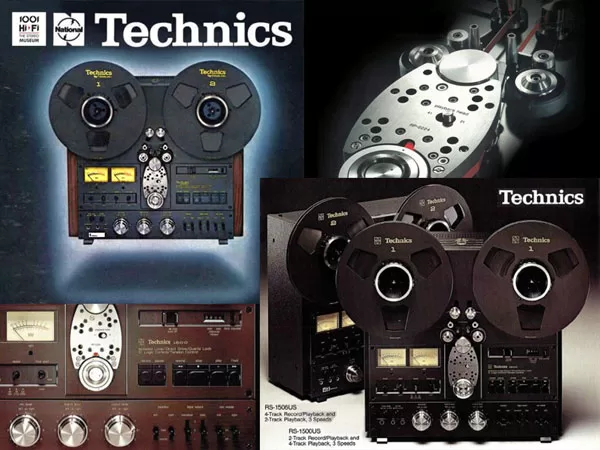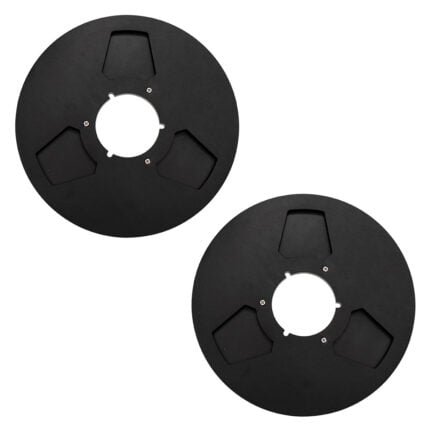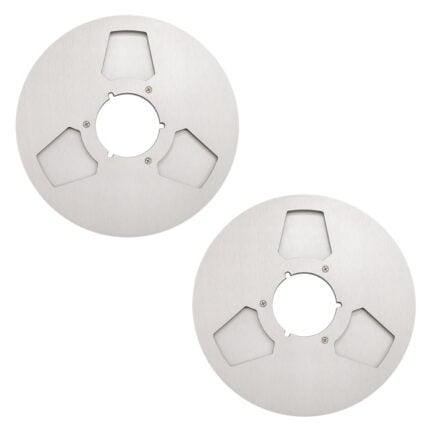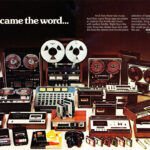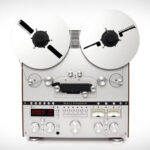Welcome to our guide on reel-to-reel tape, a classic audio format that has shaped the history of music. Reel-to-reel tape, also known as open-reel tape, is a magnetic tape format that uses a reel-to-reel system to record and play back audio.
The concept of reel-to-reel tape recording dates back to the early 20th century, with its first commercial use in the 1940s. It quickly became a popular format for recording and distributing music, and its use continued into the 1980s.
Despite the rise of digital audio technology, reel-to-reel tape remains a beloved format among audiophiles and music enthusiasts. In this guide, we’ll explore the history and technology behind reel-to-reel tape, as well as its advantages and how to use and care for it properly.
How Reel-to-Reel Works: Explained
Reel-to-reel tape recording technology involves the use of a magnetic tape housed on a reel that moves through various machine components to capture, store, and play back audio. The process is detailed and involves several steps, making it a popular choice for music recording and broadcasting.
At the heart of the reel-to-reel machine is the tape head, which reads and writes data onto the magnetic tape. The head consists of a small electromagnet that interacts with the magnetic particles on the tape, using electrical signals to encode and decode the data.
The magnetic tape is housed on a reel, which rotates as the tape moves through the machine. This rotation is controlled by a motor, which is powered by electricity. The speed of rotation and tape movement is crucial to the quality of the recording, with slower speeds typically yielding a higher quality of audio.
The machine also includes various knobs and switches to control the playback and recording of the audio. These include volume controls, level meters, and input/output jacks for connecting other audio equipment. It is important to properly calibrate these settings to achieve the best possible sound quality.
Overall, reel-to-reel tape recording is a complex but effective method of capturing and storing high-quality audio. It remains a popular choice for audiophiles and music enthusiasts due to its superior sound quality and vintage appeal.
A Brief History of Reel-to-Reel Technology
Reel-to-reel tape technology has a fascinating history that spans over a century. The first magnetic tape recorder was invented in Germany in the early 1930s by Fritz Pfleumer, but it wasn’t until the 1940s that reel-to-reel tape machines became widely available and affordable.
Reel-to-reel tape quickly became the standard format for professional recording studios due to its superior sound quality. By the 1950s, reel-to-reel tape had become more common in homes, with machines being produced by brands such as Ampex, Grundig, and Philips.
The 1960s and 1970s saw a surge in the popularity of reel-to-reel tape, with many music enthusiasts investing in high-end machines for home use. This was the golden age of reel-to-reel tape, with many classic albums being recorded and released on the format.
However, by the 1980s, the rise of digital audio formats such as CDs and MP3s saw the decline of reel-to-reel tape. Production of new machines and tapes dwindled, and it became increasingly difficult to find quality equipment and tapes.
Today, reel-to-reel tape has experienced a resurgence in popularity among audiophiles and music enthusiasts. Vintage machines and tapes are sought after for their unique listening experience and superior sound quality compared to digital formats.
The Advantages of Reel-to-Reel Tape
Reel-to-reel tape recordings are known for their superior sound quality, durability, and archival properties. Audiophiles and music enthusiasts alike appreciate the warm, natural sound that comes with playing music on a vintage reel-to-reel player.
One of the primary advantages of reel-to-reel tape is its ability to capture a wide frequency range. Unlike digital audio formats that often compress sound to save space, reel-to-reel tape allows for a dynamic range that can capture the full spectrum of sound in a recording. This results in a more lifelike listening experience that truly captures the nuances of an original recording.
Another advantage of reel-to-reel tape is its durability. Well-maintained tapes can last for decades without losing their original sound quality. They are less susceptible to scratches and wear and tear, making them a reliable choice for long-term storage and archival purposes.
Finally, reel-to-reel tape is still highly sought-after by audiophiles and music enthusiasts who prioritize sound quality and a classic listening experience. Vintage reel-to-reel players can be found at affordable prices, and the thrill of hunting down rare tapes and discovering lost recordings is an exciting pursuit for many collectors.
The Appeal of Reel-to-Reel Tape
For many audiophiles and music enthusiasts, the appeal of reel-to-reel music lies in its unique listening experience. Playing music on a vintage reel-to-reel machine brings a sense of nostalgia and connection to the past, allowing listeners to experience music in the same way it was originally recorded.
Additionally, the warm, natural sound of reel-to-reel tape creates a more emotional connection to music. The rich, full sound of the recordings can evoke feelings of nostalgia and create a deeper appreciation for the artistry and skill that went into creating the original recordings.
Overall, the advantages of reel-to-reel tape make it a desirable format for those who prioritize sound quality and a classic listening experience. Although digital audio formats have largely replaced reel-to-reel technology, the enduring appeal and popularity of vintage reel-to-reel machines prove that the format still holds a special place in the hearts of music lovers.
How to Use a Reel-to-Reel Machine
Using a vintage reel-to-reel machine can seem daunting if you’ve never done it before, but with a little practice, you’ll be enjoying your favorite tunes in no time. Here are some tips to get you started:
- Load and thread the tape: Start by placing the reel of tape on the left-hand side of the machine and the empty take-up reel on the right. Then, thread the tape through the guides and heads of the machine, making sure it is properly aligned.
- Adjust the playback speed: Most vintage reel-to-reel machines have a lever or knob for adjusting the playback speed. Consult the manual for your specific machine to determine the correct setting.
- Calibrate the machine: Before playing back a tape, it’s important to calibrate the machine to ensure optimal sound quality. This involves adjusting the bias and equalization settings to match the tape you’re using. Refer to your machine’s manual for instructions on how to calibrate it.
- Monitor the levels: While playing back a tape, keep an eye on the levels to ensure they’re not too high or too low. Adjust the volume and other settings as needed to achieve a good balance.
- Maintain the machine: To keep your machine in good working order, be sure to clean the heads and other components regularly. Refer to your manual for specific instructions on how to do this.
With these tips in mind, you’ll be able to enjoy your favorite music on a vintage reel-to-reel machine with ease.
The Care and Maintenance of Reel-to-Reel Tape
Reel-to-reel tapes are delicate and require proper care and maintenance to ensure their longevity. Here are some tips to help you preserve your tapes for years to come:
Storage
Store your tapes in a cool, dry place. Heat and humidity are the biggest enemies of reel-to-reel tapes, as they can cause the tape to degrade or warp over time. Ideally, tapes should be stored at temperatures between 50-70 degrees Fahrenheit and between 30-50% humidity. Avoid storing tapes in basements or attics, where the temperature and humidity levels can fluctuate.
When storing tapes, use cases or boxes specifically designed for reel-to-reel tapes. Avoid stacking tapes on top of each other or storing them in tight spaces where they may become damaged.
Cleaning
Regular cleaning can extend the life of your tapes and keep them sounding their best. Use a soft, lint-free cloth to gently wipe the tape’s surface, removing any dust or debris. Avoid using water or any cleaning solutions, as they can damage the tape. If the tape is particularly dirty, try using a rubber eraser to lightly lift away any grime.
Remember to keep your machine’s heads and rollers clean as well. Use a cotton swab dipped in isopropyl alcohol to gently clean the heads and rollers, removing any built-up dirt or debris. Clean the heads after every 10-15 hours of use, or more frequently if necessary.
Splicing
If a reel becomes damaged or breaks, don’t panic. Reel-to-reel tapes can be spliced back together using special splicing tape. To splice the tape, cut the damaged section out using a sharp pair of scissors, leaving a clean, straight edge. Then, use the splicing tape to attach the two ends of the tape back together, being careful to align the edges precisely.
Repairs
If your reel-to-reel machine needs repairs, it’s important to take it to a professional who has experience with vintage reel-to-reel machines. Attempting to repair the machine yourself can cause further damage and may be dangerous if you are not familiar with the inner workings of the machine.
Regular check-ups and maintenance by a skilled technician can help identify any potential issues before they become major problems.
By following these tips for care and maintenance, you can ensure your reel-to-reel tapes and machine stay in excellent condition, delivering high-quality sound for years to come.
The Appeal of Reel-to-Reel Music
For audiophiles and music enthusiasts, there is something truly special about listening to music on a vintage reel-to-reel machine. The warm, rich sound quality and the tactile experience of handling physical tape creates a unique listening experience that cannot be replicated with digital formats.
Many listeners describe a deeper emotional connection to the music when played on a reel-to-reel player, as if the music is being experienced in a more authentic and intimate way.
Reel-to-reel music also offers a glimpse into the past, allowing listeners to hear music as it was originally intended to be heard when it was first recorded. For those who appreciate the history and evolution of music technology, reel-to-reel provides a tangible connection to the past.
Reel-to-Reel vs. Digital Audio
When it comes to audio formats, reel-to-reel tape and digital audio have some notable differences. While digital audio formats offer convenience and accessibility, reel-to-reel tape remains a sought-after format for those who prioritize sound quality and a classic listening experience.
The Advantages of Reel-to-Reel Tape
Reel-to-reel tape offers many advantages over digital audio formats. Its analog format captures audio signals in a continuous stream, resulting in a warmer, more natural sound quality that audiophiles covet.
Additionally, reel-to-reel tape has a much longer lifespan than digital audio files, with well-stored tapes lasting for several decades without significant degradation. This makes it an excellent format for archiving and preserving music.
Convenience and Accessibility of Digital Audio
While reel-to-reel tape offers superior sound quality, digital audio formats offer unparalleled convenience and accessibility. With digital audio, you can easily store thousands of songs on a single device and access them quickly and easily. Additionally, digital audio files are easier to share and distribute, making it a more practical format for many people.
However, it’s important to note that the sound quality of digital audio formats can vary depending on the bit rate and compression used, often resulting in a loss of audio fidelity compared to reel-to-reel tape.
The Classic Listening Experience of Reel-to-Reel Tape
Reel-to-reel tape offers a unique listening experience that’s hard to replicate with digital audio. The process of physically loading and threading the tape, adjusting the playback speed, and listening to the music through high-quality speakers or headphones creates a more intimate and emotional connection with the music.
For audiophiles and music enthusiasts, the classic listening experience of reel-to-reel tape is unmatched, making it a format that will continue to endure for many years to come.
The Future of Reel-to-Reel Tape
Despite the popularity of digital audio formats, reel-to-reel tape has retained a dedicated following among audiophiles and music enthusiasts. In recent years, there has been a resurgence of interest in vintage reel-to-reel machines and tapes, and modern advancements have been made in reel-to-reel tape recorders.
With its superior sound quality and durability, reel-to-reel tape is likely to continue to have a place in the world of audio technology. Many believe that the format will remain in demand for its classic listening experience and emotional connection to music.
As technology continues to advance, it will be interesting to see how reel-to-reel tape evolves and adapts to the changing landscape of the music industry. Whether through advancements in tape technology or innovative new uses for vintage machines, reel-to-reel tape is poised to remain a beloved format for years to come.
The Best Reel-to-Reel Tape Players Available Today
For audiophiles seeking a classic listening experience, few formats compare to reel-to-reel tape. Here are some of the best reel-to-reel tape players currently available on the market:
| Player | Features | Price |
|---|---|---|
Technics RS-1500US (eBay Germany) Technics RS-1500US (eBay US) | Three motors, direct-drive capstan, balanced input/output, three heads | $6,000+ |
Pioneer RT-909 (eBay Germany) Pioneer RT-909 (eBay US) | Two heads, closed-loop dual-capstan transport, Dolby noise reduction, built-in oscillator | $1,500-$3,000 |
Teac A-7300 (eBay Germany) Teac A-7300 (eBay US) | Two heads, dual-capstan transport, auto-reverse, Dolby noise reduction | $700-$1,200 |
While vintage reel-to-reel machines can be found on the used market, these models have been newly manufactured as of 2021 and are highly sought after for their high-quality sound and reliability.
When selecting a reel-to-reel player, it is important to consider your personal preferences, budget, and intended usage. Whether you are a seasoned audiophile or a newcomer to the world of reel-to-reel, these machines are sure to provide a listening experience like no other.
The Top Reel-to-Reel Tape Brands
When it comes to vintage reel-to-reel tape, there are a few brands that stand out for their quality and reputation. Here are some of the top reel-to-reel tape brands to look out for:
| Brand | Description |
|---|---|
| Ampex | Ampex was founded in 1944 and quickly became a leader in reel-to-reel tape technology. They were known for their high-quality tapes and their machines, which were used by professional recording studios around the world. |
| Scotch | Scotch was a brand of 3M that produced a range of audio and video products, including reel-to-reel tape. Their tapes were known for their durability and high-quality sound, and they were popular with both amateurs and professionals. |
| Sony | Sony was founded in 1946 and quickly became a major player in the electronics industry. They produced a range of reel-to-reel tape machines and tapes, which were known for their high-quality sound and reliability. |
| Maxell | Maxell was a Japanese brand that produced audio and video products, including reel-to-reel tape. They were known for their high-quality tapes, which were used by professionals and audiophiles alike. |
| TDK | TDK was a Japanese company that produced a range of audio and video products, including reel-to-reel tape. Their tapes were known for their high-quality sound and durability, and they were popular with both professionals and amateurs. |
These are just a few of the top reel-to-reel tape brands to look out for. Keep in mind that vintage tapes and machines can be expensive and difficult to find, so be prepared to do some research and invest some time and money if you’re interested in exploring this fascinating technology.
Reel-to-Reel Tape: How to Get Started
If you’re new to reel-to-reel tape technology, the idea of getting started can be daunting. Don’t worry! Setting up a basic machine is straightforward, and with a little practice, you’ll be enjoying high-quality audio in no time.
The first thing you’ll need is a reel-to-reel machine. Vintage machines are readily available through online marketplaces or retro electronics stores, but be sure to research a seller’s reputation and read reviews before making a purchase.
You’ll also need reels of tape. Look for high-quality tape that is 1/4 inch in width and comes in standard lengths of 1200, 1800, or 2400 feet. New, unused tape can be found through specialty music retailers or online, but if you’re starting on a budget, used tapes can also be found through online marketplaces.
Once you have your machine and tapes, it’s time to set up. Begin by plugging in your machine and speakers. Be sure to read the user manual carefully to ensure you understand the machine’s controls and features.
To load a tape onto your machine, open the cover and place the empty reel on the left spindle and the full reel on the right spindle. Thread the tape across the machine’s heads and through the guides, then use the machine’s controls to wind the tape onto the empty reel.
Adjust the machine’s speed and volume as needed, and enjoy the high-fidelity sound of reel-to-reel audio. With some practice, you’ll be able to master the art of using a vintage reel-to-reel machine and enjoy the unique listening experience it provides.
Reel-to-Reel Tape: Frequently Asked Questions
If you’re new to the world of reel-to-reel tape technology, you may have some questions. Here are answers to some of the most frequently asked questions:
What is the difference between reel-to-reel tape and other audio formats?
Reel-to-reel tape offers superior sound quality, durability, and archival properties compared to other audio formats. It captures a more detailed and natural sound, making it popular among audiophiles and music enthusiasts.
What are the essential components of a reel-to-reel tape recorder?
The essential components of a reel-to-reel tape recorder include the tape transport, playback head, record head, erase head, and amplifier. These work together to capture, store, and play back audio.
How do I clean and maintain my reel-to-reel tapes?
To clean your reel-to-reel tapes, gently wipe them with a clean, dry cloth or use a tape cleaning solution specifically designed for reel-to-reel tapes. It’s important to store them in a cool, dry place away from extreme temperatures or humidity. Avoid touching the tape directly with your fingers, and handle them carefully to avoid stretching or damaging the tape.
What is the difference between vintage and modern reel-to-reel tape players?
Vintage reel-to-reel tape players are typically considered to offer superior sound quality and a more authentic listening experience than modern players. However, modern players may offer more convenience and features such as USB connectivity or built-in speakers.
Can I still find reel-to-reel tapes to purchase?
Yes, reel-to-reel tapes can still be found for purchase online or in specialty stores. You may also be able to find them at estate sales or through private sellers. We at Retroreels.shop have Technics style reels based op the Technics RP-10A
How can I digitize my reel-to-reel tape collection?
You can digitize your reel-to-reel tape collection by using a reel-to-reel tape player and a digital audio interface. Simply connect the player to your computer and use audio software to record and save the digital files.
Why is reel-to-reel tape technology still relevant today?
Reel-to-reel tape technology is still relevant today due to its superior sound quality and unique listening experience. It offers a more natural, organic sound that can’t be replicated by digital formats. It also has archival properties, allowing for long-term preservation of audio recordings.
Tips for Preserving Your Reel-to-Reel Tape Collection
If you are a proud owner of a reel-to-reel tape collection, it’s important to take the necessary steps to preserve your tapes for long-term enjoyment. Here are some useful tips:
- Store your tapes properly: Keep your tapes in a cool, dry place away from direct sunlight and extreme temperatures. Avoid storing them near windows or heaters as they can cause damage to the tape and degrade the audio quality over time.
- Handle your tapes with care: When handling your tapes, make sure to clean your hands and handle them with clean, dry fingers. Avoid touching the magnetic surface of the tape to prevent damage or distortion of the audio quality.
- Digitize your tapes: Consider digitizing your reel-to-reel tape collection to preserve the audio quality and ensure long-term accessibility. There are various digitization services available that can help you transfer your tapes to a digital format.
- Back up your digitized collection: Once you have digitized your tapes, make sure to keep a backup copy of your collection in a secure location such as an external hard drive or cloud storage. This will ensure that your collection is protected from damage or loss.
- Regularly inspect your tapes: Make sure to inspect your tapes regularly for any signs of wear and tear. Look out for cracks, warping, or discoloration, as these can indicate damage to the tape that may affect audio quality.
- Splice and repair damaged tapes: If you notice any damage to your tapes, such as a crack or a break, it’s important to repair it as soon as possible. You can splice the tape using special tape splicing tools or seek the help of a professional audio restoration service.
By following these tips, you can ensure that your reel-to-reel tape collection remains in pristine condition and that you can continue to enjoy the superior audio quality that this classic technology provides.
The Enduring Legacy of Reel-to-Reel Technology
Despite the rise of digital audio formats and the decline of physical media, the enduring legacy of reel-to-reel technology continues to captivate audiophiles and music enthusiasts around the world. From its early beginnings in the mid-20th century to its resurgence in popularity today, reel-to-reel tape has played an important role in shaping the way we experience music.
One of the key aspects of reel-to-reel’s lasting appeal is its superior sound quality. Unlike modern digital formats, which rely on compression and other techniques to compress audio into smaller files, reel-to-reel tape captures sound in its purest and most natural form. This results in a listening experience that is more dynamic, nuanced, and authentic than what can be achieved with digital audio.
In addition to its sound quality, reel-to-reel tape is also prized for its durability and archival properties. Tapes that have been stored properly can last for decades or even longer, making them a valuable investment for serious audiophiles and collectors.
Despite its age and relative obscurity, reel-to-reel technology continues to evolve and adapt to changing times. Modern reel-to-reel tape recorders offer many of the same features and capabilities as their vintage counterparts, making it easier than ever for enthusiasts to experience the magic of reel-to-reel tape.
Whether you’re a seasoned audiophile or simply curious about the world of vintage audio technology, reel-to-reel tape is a fascinating and rewarding format that deserves to be explored. Its enduring legacy continues to shape the way we listen to and appreciate music, and its influence can still be felt in the music industry and audio technology as a whole.
Reel-to-Reel Tape: Final Thoughts and Conclusion
Reel-to-reel tape has a rich history and continues to captivate audiophiles and music enthusiasts alike. Its superior sound quality, durability, and archival properties make it a desirable format for music lovers who want to experience music in its purest form.
While digital audio may be more convenient and accessible, reel-to-reel offers a unique listening experience that cannot be replicated. The emotional connection that comes with playing music on a vintage reel-to-reel machine is unmatched by any other format.
As technology continues to advance, reel-to-reel tape is still relevant and sought-after by music enthusiasts. Modern advancements in reel-to-reel tape recorders and continued interest in the format by audiophiles ensure its legacy will endure for years to come.
If you are interested in exploring the world of reel-to-reel tape for yourself, there are many resources available to help you get started. From vintage machines to high-end tape players, finding the right equipment can enhance your listening experience and bring new life to your music collection.
The Timeless Appeal of Reel-to-Reel Technology
Reel-to-reel tape has had a lasting impact on the music industry and audio technology as a whole. Its unique sound and enduring legacy ensure that it will continue to be cherished by music lovers for generations to come.
So why not take a step back in time and experience the magic of reel-to-reel tape for yourself? With its timeless appeal and unmatched sound quality, it’s sure to be an experience you’ll never forget.


